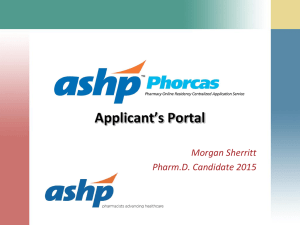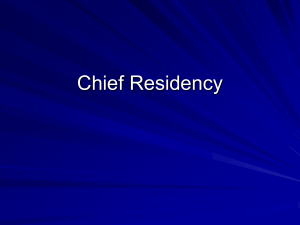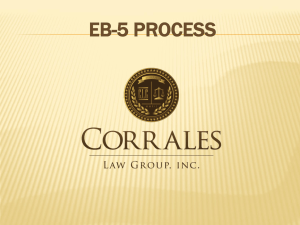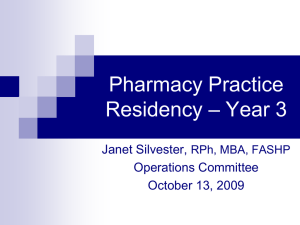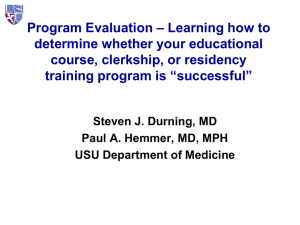Developing an ASHP Approved Residency Program
advertisement
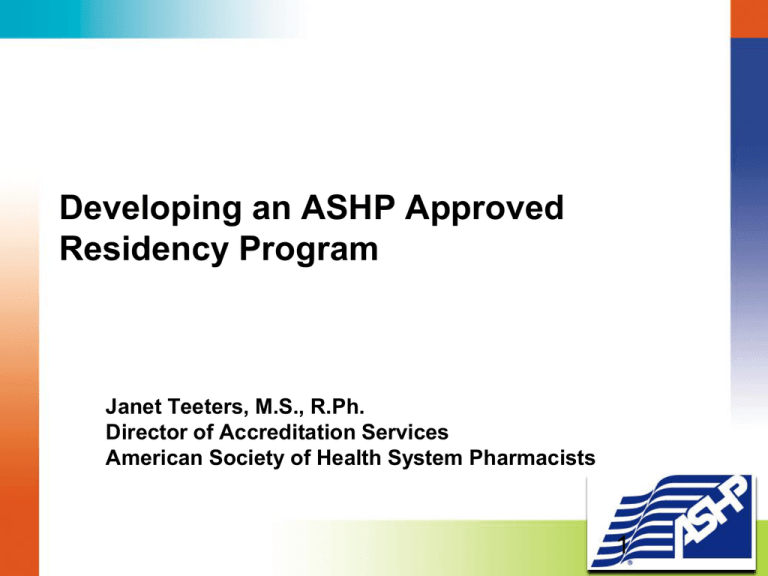
Developing an ASHP Approved Residency Program Janet Teeters, M.S., R.Ph. Director of Accreditation Services American Society of Health System Pharmacists 1 Objectives 1. 2. 3. Provide examples of action you can take to develop a residency program. Describe three factors that will help make your residency program a success. Summarize the steps to have your residency program become accredited. 2 Questions to ask yourself? Why do you want to start a residency? What does your site have to offer? Are you & your staff ready for a major commitment to the program? This is more than just taking pharmacy students on rotation…. 3 Residency vs Experiential Training Experience vs exposure Integrating knowledge, skills, abilities & attitudes to gain confidence in practice Repetition to reinforce development Ability to develop skills progressively Self selected group of individuals desiring to advance their skills 4 Residencies are the bridge between Education and Practice Helping to develop clinical & professional maturity 5 How to begin? Initial assessment Costs of the program Support for program Justification Program Design Individuals Role Recruitment Accreditation 6 Initial assessment Philosophy Organization Department Staff (experience, interest, commitment) Services (scope & depth) Resources available Costs 7 Costs of a residency program Preceptor and program directors time Space and equipment Salaries and benefits of residents Travel Recruitment expenses Training of Preceptors Accreditation Fees 8 Gathering support Pharmacy Physicians Administration Nursing 9 Justification Patient care services Projects & programs Medicare Pass through for post graduate medical education (if accredited) Recruitment and retention of staff Keeps the department contemporary Enhance credibility within an institution 10 Program Design Purpose # residents Structure College affiliation, teaching opportunities Utilization of outside experiences 11 Program Design Use a systematic approach Understand instruction Focus on assessment & feedback Roles & responsibilities 12 Systematic Approach to Training Outcomes, Goals & Objectives Assessment Program Design Instruction 13 ASHP Residency Learning System “RLS” Model for a systematic approach to training Maximize learning experiences Builds upon past experiences Focuses on improving instruction & feedback Provides consistency in assuring outcomes 14 Outcomes, Goals & Objectives Outcomes: What resident graduate should be capable of doing Goals: What resident should learn to do Objectives: Observable, measurable behavior Criteria: Detail to evaluate performance related to the objectives Outcomes Goal Goal Obj Obj C Obj C CCC C CC C 15 Outcome: Provide patient centered care Goal: Document patient care activities appropriately Objective: Appropriate selection of activities Objective Effectively document appropriate information Objective: Explain exemplary documentation Criteria: Written in time to be useful Criteria: Follows Hospital Policy Criteria: Legible Criteria: Only pertinent information included Criteria: Accurate interpretation 16 Outcomes, G&O Selection Tips: Include required outcomes, goals & objectives Limit the total number of outcomes 17 Design Learning Experiences (rotations) Areas of expertise Determine length, type, electives Identify goals that match the experience Identify goals to be evaluated during the experience Identify learning activities to meet G&O 18 Design Tips: Only offer rotations - good role models and adequate patient #s Focus on the strengths of the site Strong role models for early experiences Limit the number of goals evaluated per rotation Don’t repeat the evaluation of the same goals with every rotation if goal has been obtained Develop effective communications between 19 preceptors to avoid duplication of efforts Provide Instruction Stage of Learning Bloom’s – level of cognitive learning Methods of Instruction Foundation Knowledge, skills Knowledge Comprehension Reading, lecture Guided discussion Interactive lecture Practical Application Application Analysis Synthesis Case presentation Case based teaching Simulation Practice based teaching Integration Evaluation Practice based facilitation 20 Preceptors Role Facilitating Residents Learning Culmination & integration Coaching Practical Application Modeling Direct Instruction & Knowledge Foundation Skills 21 Instruction Tips Educate preceptors on how resident training varies from student training Provide forum for preceptors to discuss effective methods they have used to learn from each other Provide development for preceptors 22 Assessment & Feedback Effectively “diagnose” Provide effective guidance - criteria Constructive criticism Maximize residents progress Improve programs performance 23 Assessment & Feedback Tips Key area of focus Can use a variety of methods to document feedback Use tools already developed 24 “ You are unaware of the effect you have on others.” Chinese fortune cookie 25 Key Individuals Residency Program Director Preceptors All staff 26 Residency Program Director Role Overall Champion for the program Initial assessment of entering resident Development of resident plan Monitoring of resident over time Assess preceptors & be a preceptor Assess program performance Improvement of the program 27 Preceptors Role Responsible for their experiences/rotation Instruction Feedback Formative - constructive ongoing use snap shots/ criteria based checklists Summative – at the end of an experience Attainment of G&O assigned Receive Improve effectiveness Communicate to other preceptors 28 Overall challenges of design & implementation Understanding the systematic approach RPh have not been trained in educational design Focusing on paperwork vs concept Need to involve all preceptors in design Takes time Everyone needs to be educated New staff CQI 29 If you build it they will come……. 30 not exactly…. Recruitment Market yourselves! ASHP Midyear Mtg Students, Staff Other residency programs in your area Un-matched candidates post MATCH (March) State, regional, college presentations Brochures/ web pages Seeking accreditation 31 “ If you always do what you have always done, you’ll always get what you always got.” anonymous 32 Accreditation Acts as a catalyst to promote change and provide consistency in training A voluntary process to show a program meets national standards A means of self-regulation, using peer review 33 Why accreditation? Consumer protection Fosters continuous improvement Public relies on accreditation for Credibility Consistency Funding Recognition 34 What’s involved from the accreditation side? Standard development Measuring compliance Review process Education 35 What’s involved from your side? Program development Resident recruitment Application/ Reapplication Survey visits and reports Meeting & keeping current with standards Constantly improving your program Keeping your information up to date with ASHP 36 Accreditation application process Read the standards & regulations Must have a resident Fees begin as soon as you apply Application includes program director information Information goes live on web site Site visit (after 9 months) Accreditation is retroactive to application date On going reports 37 What to expect after application Set Survey date Self- assessment Site survey Correspondence in response to report ASHP Commission on Credentialing ASHP Board of Directors 38 Residency Evaluation Process Pre-survey Self Evaluation Prepared by Site ASHP Site Visit (every 6 years) Report by Surveyors & Site Follow up to Findings Review by Commission on Credentialing (meets 2/yr) no, 1, 3, or 6 year Accreditation Interim Reports Next Site Visit 39 TOP Areas of Partial/Non-compliance in Pharmacy Practice Residency training issues: • Preceptors’ Contribution to Profession • Individualized Plan for Resident Assessment of the Resident Resident Self Evaluations Progress over Time & Feedback 55% Document/plan for leave & impact • • • • 2006 56% 50% 44% 41% 2005 67% 54% 51% 44% ---- 2004 58% 47% 44% 56% 36% 2003 ---55% 61% 61% 44% 59% ---- ---- ---- Based on 3/03, 3/04, 3/05, 3/06 COC 40 TOP Areas of Partial/Non-compliance in Pharmacy Practice Pharmacy or service issues: • Sterile Products Area • Safe Drug System • Drug Information 48% 2006 2005 2004 2003 66% 63% 79% 59% 47% 51% 65% 56% 58% 74% 49% Based on 3/03, 3/04, 3/05, 3/06 COC 41 TOP areas of Partial/Non-compliance Specialized Programs in Residency training issues: • Individualized goals/objectives • Evaluations not routinely done • Individual plan & monitored 56% • Resident has not completed PGY1 • Resident self evaluation 44% 2006 67% 48% 2005 56% 52% 52% 2004 97% 81% 44% 2003 63% ---94% 54% 44% 52% 32% ---- 50% 19% Based on 3/03 , 3/04, 3/05, 3/06 COC 42 New Residency Accreditation Standards 43 Factors related to release of new Residency Accreditation Standards IOM reports JCAHO Roundtable/conference Future of Residency Training Conference ACCP/ASHP Partnership Open Hearings & comment periods ACPE standards 44 IOM - Core competencies for all health professionals •Patient-centered •Interdisciplinary teams •Evidence-based practice •Utilize informatics •Apply quality improvement 45 Residency Stakeholders Conference Accreditation by one national body that includes key stakeholders All residencies should be accredited Residencies help develop innovative practices Colleges provide knowledge; residencies are becoming necessary to integrate knowledge into practice 46 Residency Stakeholder Conference ↑ need for residency trained individuals by 2015 ↑ need for community residencies PGY1 & PGY2 is appropriate model Terms and vision need to be consistent, defined, endorsed and embraced by the profession Specialization in the profession needs clarity 47 New Standards: PGY1 Pharmacy Residency Replaces Pharmacy Practice (2001) PGY2 Pharmacy Residency Replaces Specialized Pharmacy Practice (1994) and all supplemental standards (Goals & objectives remain) Standards not altered at this time: Managed Care Pharmacy Practice Managed Care Systems Residency Pharmacy Practice (with emphasis in Community Care) 48 PharmD Graduate Basic Patient/Practice FOCUS Broad A PGY1 Generalist Wide variety of patients & diseases DEPTH of knowledge, skills, abilities, experience C PGY2 Advanced Practitioner More experience, skill and ability developed in a broad set of patients (e.g., pharmacotherapy) Narrow PGY1 B Generalist Focused Practitioner Wide variety of diseases may be in a unique setting or population (e.g., pediatrics, geriatrics, ambulatory, managed care) PGY2 D Advanced Practitioner More experience, skill, and ability developed in a focused area of practice (e.g., oncology, critical care) Advanced 49 Principles of accreditation 1. 2. 3. 4. 5. 6. 7. Resident’s qualifications Environment for learning Resident’s responsibilities Training program (systematic approach) Residency Program Director & Preceptors Organization Pharmacy 50 New Standards PGY1/PGY2 General training vs. advanced depth of training Incorporates IOM core competencies Duty hours Participation in the match 51 PGY1 - 6 Core Competencies Medication use process Quality IOM IOM IOM IOM Improvement Patient-centered care Interdisciplinary Evidence Teams Based Practice Leadership and management Project management Education/training Medical informatics IOM 52 PGY2 Residency Program Directors PGY2 Residency & 3 years or 5 years of experience in the area BPS - Board Certification Nuclear Nutrition Oncology Psychiatry Pharmacotherapy + added qualifications Infectious Diseases Cardiology 53 Why is accreditation important to a resident? Think of the residents expectations they are giving up a year of full salary, with college loans to do this program. Accelerates development of their practice skills Competitive advantage in the market place Mentorship Networking opportunities Career planning Shows that the site is committed to excellence Ensures they are not used as cheap labor 54 Why is accreditation important to a site? Funding – where applicable Commitment to excellence Means of self regulation CQI Helps advance the practice of pharmacy Recruit and retain staff & residents Enhanced credibility 55 Seek advice from others: Other Residency Programs & preceptors ASHP – Accreditation Services http://www.ashp.org/rtp/index.cfm ASHP Midyear Clinical Meeting – new and prospective residency program workshops and town hall meeting ASHP National Residency Preceptors Conference ASHP Residency Learning System – training programs Colleges of pharmacy 56 STARTING YOUR RESIDENCY PROGRAM 57 Objective 1 Actions you can take to develop a residency Assessment Identify Costs Justification Learn about systematic approach Design Program Train & educate Strategy for recruitment Review ASHP accreditation standards 58 Objective 2 Factors to help make your residency program a success Champion & commitment Thorough education and preparation Involve as many individuals as possible Must realize this is about education and may need to learn new principles different then how you were taught Realize this is not a short term process – it improves with time and continuous improvement This involves the entire department, not just a few 59 Objective 3 Steps to have residency become accredited Read standards & regulations Begin design based on standards Seek advise from others Attend training programs (RLS, new programs, NRPC/MCM) Design program with involvement of many Recruit a resident Apply! 60 Just do it! 61 62
